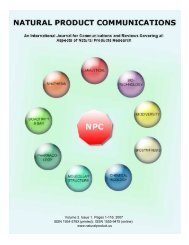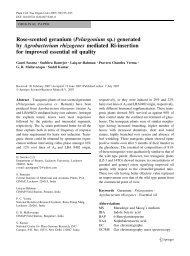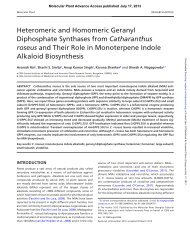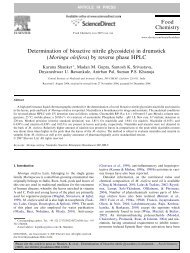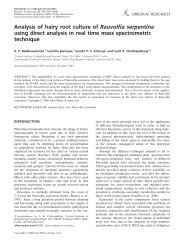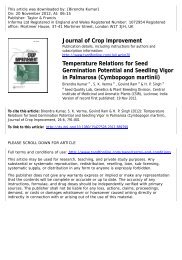Ocimum basilicum L. - CIMAP Staff - Central Institute of Medicinal ...
Ocimum basilicum L. - CIMAP Staff - Central Institute of Medicinal ...
Ocimum basilicum L. - CIMAP Staff - Central Institute of Medicinal ...
You also want an ePaper? Increase the reach of your titles
YUMPU automatically turns print PDFs into web optimized ePapers that Google loves.
534 B. KumarDownloaded by [<strong>CIMAP</strong> <strong>Central</strong> <strong>Institute</strong> <strong>of</strong> <strong>Medicinal</strong> & Aromatic Plants], [Birendra Kumar] at 01:56 06 August 2012essential to both commercial growers and seed production companies forensuring crop performance (Karlovich 1998), and for pre-and post-harvestprocessing for premium quality seed production (Oakley, Kester, & Geneve2004). Because Indian basil is seed propagated and its commercial growerssuffer major losses caused by substandard seeds, it is essential to assess thegermination potential and vigor for ensuring the crop stand and herb yield.The objectives <strong>of</strong> the present study were to investigate effects <strong>of</strong> temperatureon seed germination and seedling vigor <strong>of</strong> Indian basil (Cv. CIM-Saumya).This variety is a high-yielding improved variety that was developed andreleased by <strong>Central</strong> <strong>Institute</strong> <strong>of</strong> <strong>Medicinal</strong> and Aromatic Plants and is verypopular among growers in northern India where about 100 ha are underbasil cultivation.MATERIAL AND METHODSGermination and Vigor IndexThe seed <strong>of</strong> <strong>Ocimum</strong> <strong>basilicum</strong> variety CIM-Saumya was collected in themonth <strong>of</strong> December 2009 from the crops grown at research farm <strong>of</strong> <strong>Central</strong><strong>Institute</strong> <strong>of</strong> <strong>Medicinal</strong> and Aromatic Plants, Resource Centre, Hyderabad,India. The seeds were stored in paper bags at 20 ◦ C ± 2 ◦ C until neededfor experimentation. The experiment was conducted during July–August2010 at temperatures <strong>of</strong> 15 ◦ C, 20 ◦ C, 25 ◦ C, 30 ◦ C, 35 ◦ C, and 40 ◦ Cat16hlight (180 lx)/8 h dark daily regimes with 70%–80% relative humidity. Seedswere placed on top <strong>of</strong> filter paper (TP) (15 cm diameter) soaked with steriledistilled water in Petri dishes (16 cm diameter × 3 cm deep). The experimentwas conducted in two sets, and each set had four replicates <strong>of</strong> 100 seeds.Germination was checked daily and numbers <strong>of</strong> normal (bearing both rootand shoot) and abnormal (lacking either root or shoot or having stuntedgrowth) seedlings recorded from first day <strong>of</strong> counting until the day <strong>of</strong> maximumseed germination percentage (Kumar, Verma, & Singh 2011). Numbers<strong>of</strong> normal seedlings were used for data analysis. Germination percentage,seedling vigor index I, and seedling vigor index II were calculated (ISTA2010; Khosla, Chhillar, & Kashyap 2006; Kumar, Verma, & Singh 2011) asfollows:total number <strong>of</strong> seeds germinatedGermination percentage =total number <strong>of</strong> seeds in all replicates × 100Seedling vigor index I = germination (%) × average seedling lengthFrom each replication, five normal seedlings were selected randomly atthe end <strong>of</strong> germination test, and seedling length (root + shoot length) wasmeasured. Average seedling length (cm) was calculated.




